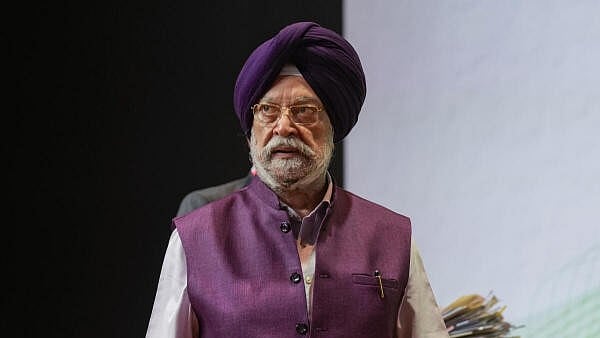
Union Minister for Petroleum and Natural Gas Hardeep Singh Puri.
Credit: PTI Photo
Mumbai: India will soon touch the six million barrels crude oil consumption per day, according to Minister of Petroleum and Natural Gas Hardeep Singh Puri.
"India currently consumes about 5.6 million barrels of crude oil per day, compared to 5 million barrels four-and-a-half-years ago. At the present rate of growth, the country will soon reach 6 million barrels per day,” Puri said addressing the India Maritime Week in Mumbai on Wednesday.
Puri said according to the International Energy Agency, India is expected to contribute nearly 30 per cent of the global rise in energy demand in the next two decades, an increase from the earlier estimate of 25 per cent.
“This growing energy requirement will naturally increase India’s need for ships to move oil, gas, and other energy products across the world,” the diplomat-turned-politician said.
The minister said that India’s economy is growing fast, with the GDP now around $4.3 trillion - nearly half of this comes from the external sector, which includes exports, imports, and remittances. “This shows how important trade—and therefore shipping—is for India’s economic progress,” he said.
The Minister Informed that during 2024–25, India imported around 300 million metric tons of crude and petroleum products and exported about 65 million metric tons.
The oil and gas sector alone accounts for nearly 28 per cent of India’s total trade by volume, making it the largest single commodity handled by ports. He said that India currently meets about 88 per cent of its crude oil and 51 per cent of its gas needs through imports, which shows how important the shipping industry is for the country’s energy security.
He explained that the freight cost forms a significant part of the total import bill.
“Oil marketing companies pay around $5 per barrel to transport crude from the United States and about $1.2 from the Middle East. Over the last five years, Indian PSUs such as IOCL, BPCL, and HPCL have spent nearly $8 billion on chartering ships, an amount that could have built a new fleet of Indian-owned tankers,” he said.
Puri pointed out that only about 20 per cent of India’s trade cargo is carried on India-flagged or India-owned vessels. He said this presents both a challenge and an opportunity for India to increase its ship ownership and manufacturing capacity.
“The government is working on steps like aggregating PSU cargo demand to give long-term charters to Indian carriers, advancing the Ship Owning and Leasing (SOL) model, setting up a Maritime Development Fund for affordable vessel financing, and implementing Shipbuilding Financial Assistance Policy 2.0 with higher support for LNG, ethane, and product tankers,” he said.
He said India’s shipyards such as Cochin Shipyard, Mazagon Dock, GRSE Kolkata, HSL Visakhapatnam, and private yards in Goa and Gujarat are now building world-class vessels. Partnerships like Cochin Shipyard with L&T and Daewoo for LNG and ethane carriers, and collaborations with Mitsui OSK Lines, are helping bring global technology into Indian shipyards.